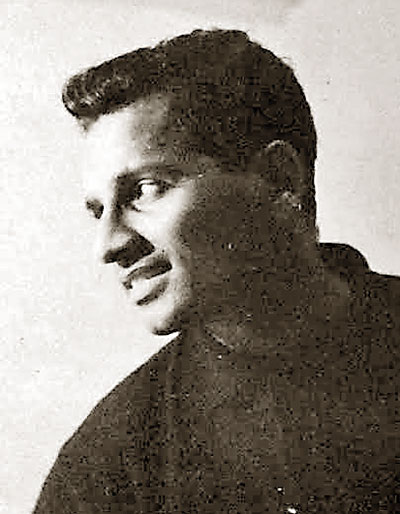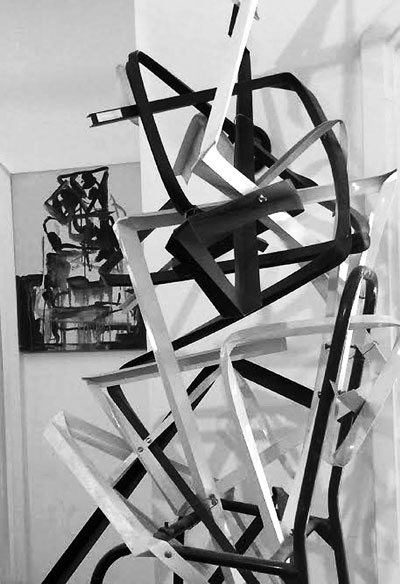Art as a Place: The unassuming modernist
View(s):By Jyoti Dhar
It takes several studio visits to get to the core of Dr. H. A. Karunaratne’s practice; not just because of the gentle and impressive octogenarian’s prolific artistic output, or because of the range of abstraction his canvases, sculptures and prints seem to embody, rather because each piece in his oeuvre aims to elicit a stillness of gaze or suspension of time.

The young artist in 1962
Within the first minute of us meeting in his garden in Nugegoda, the soft-spoken artist starts to walk me through his work, from the broken terracotta-and-tile mural and futuristic found-object sculptures that envelop his home, to the stacks of canvas boards arranged inside his living room, layered in wallpaper, paint, fabric, burns and metal parts.
There must be over 500 works here – and viewed together they evince an anxious excess. Seen individually, however, they begin to reveal a calm and endless pursuit. Some evoke the Abstract Expressionist or Zen-like approach of Mark Rothko or V. S. Gaitonde, others the assemblage or conceptualist practice of Robert Rauschenberg or Hassan Sharif.
These immediate reference points help to position Karunaratne’s extensive body of work, from the 1950s up until the present-day, somewhere between modernist ideals and post-modernist ruptures, as one that draws equally from Eastern and Western schools of thought. But it is his rigorous and relentless approach to abstraction which sets him apart.
In a 2009 essay Jagath Weerasinghe claimed, “It was essentially Karunaratne’s work that institutionalized the non-figurative and abstract tradition of art making in 20th Century Sri Lankan art. He is the first Sri Lankan artist to develop a complete discourse on abstract art…” It is surprising then, that there is still so little on record about this 88 year-old artist.
As part of redressing this, a monograph on the relatively overlooked abstractionist, commissioned by a Kandy-based collector and written by Anoli Perera, is due to be published later this year. Karunaratne himself, however, is in no rush. “It takes time for people to understand me,” he says rather philosophically. “I’m still waiting for that time.”
Born in 1929, Karunaratne grew up in the tranquil lakeside village of Kothalawala in Bandaragama, about an hour away from Colombo. As a young man, he attended the Government College of Fine Arts in Colombo (1952-58), just as a wave of nationalism in newly-independent Ceylon was fuelling the work of some Sinhala-speaking modernists.
While these artists were largely influenced by the Bengal school, Karunaratne was more interested in artists developing contextual and hybrid forms of modernism, such as ’43 Group members Justin Daraniyagala and George Keyt. He was also emboldened by the progressive tutelage of painter Stanley Abeysinghe and portraitist David Paynter.
 Encouraged by the fervent artistic activity at home, Karunaratne wished to further his exposure to art movements abroad. Opportunity came, first through a Japanese government scholarship to the Tokyo National University of Fine Arts and Music (1959-61), and then through a Fulbright Award to the Pratt Institute in New York (1965-66).
Encouraged by the fervent artistic activity at home, Karunaratne wished to further his exposure to art movements abroad. Opportunity came, first through a Japanese government scholarship to the Tokyo National University of Fine Arts and Music (1959-61), and then through a Fulbright Award to the Pratt Institute in New York (1965-66).
Tokyo and New York were hot-beds of artistic innovation in the early 1960s, with movements in both cities foregrounding conceptualism and pluralism. In the latter, he describes communing with original art by Jackson Pollock and Willem de Kooning. The former helped him to develop his printmaking practice and find solace in Zen philosophy.
After these experiences, Karunaratne returned to Sri Lanka ever more convinced that art is ultimately a quest for truth or essence; one that is to be found through balance, process and experimentation. Throughout the 1970s and 80s, he pursued a largely non-figurative practice, alongside teaching at the University of Keleniya (now UVPA) in Colombo.
During this period, abstract paintings such as “The New Moon Painting” (1985) and “Mother and Child” (1988) – with main their focus on light and colour – show that though Karunaratne was using life and landscape as a point of departure, he was already moving away from the outside world, toward what Wassily Kandinsky termed an “inner sound.”
In our interview, Karunaratne talks of his affinity with Kandinsky, and certainly shares aspects of his outlook on art – from its spiritual significance and musical resonance, to its phenomenological underpinning. Karunaratne’s worldview, however, is informed by a decidedly Buddhist grounding in which he sees the act of painting as akin to meditation.
For the next couple of decades, contemplative works such as “Enlightenment” (1970), alongside other lithographs and wood-cuts, garnered the artist critical acclaim, earning him participation in the 10th Sao Paulo biennale, 1st Asian art biennale in Dhaka, as well as exhibitions with Indian printmaker Anupam Sud and Pakistani painter Amin Gulgee.
His serene approach to printmaking and painting also influenced a number of younger Sri Lankan artists around this time, including abstractionist Jagath Ravindra. In the 1990s, however, after he stopped teaching, Karunaratne’s practice seemed to take on a different impetus; one that was no longer governed by form, narrative or medium at all.
As part of his search for pure abstraction, the artist decided to stop titling his works altogether; hoping that this would urge viewers instead to slow down and seek beyond. “People search for meaning amongst the meaningless,” he says of this. “They want to understand it in one minute. But it takes a lifetime to appreciate a work of art.”
In the early 2000s, Karunaratne, ever the experimentalist, began using materials around his home – whether it be discarded glass bottles, terracotta bowls or metal chairs – to make hundreds of angular and architectonic sculptures. Many of these constructions also found their way into his abstract paintings, along with burns, perforations and tears.
For him, these multidimensional works were not about the objects themselves, but simply more ways of finding enlightenment, through the daily making of work. “Art is not for your eyes, but for your soul,” he asserts. When I visited him in January, his most recent series consisted of gestural swathes of black paint snaking across large white canvases.
Wedged between a time when modernism in art was largely figurative, and references to Buddhism were weighted with politics, Karunaratne remains singular in his apolitical, spiritual, five decade pursuit of abstraction in Sri Lanka. With unwavering commitment, he has stayed his own course and deserves overdue recognition for his distinctive oeuvre.
Art as a Place derives its name from the Sarai Reader 09 exhibition (2013) in New Delhi, curated by Raqs Media Collective.


